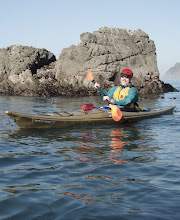I installed the first strip!!!!
 The first strip
The first stripI started by doing a bevel that approximately matches 1/2 of what is required where the deck meets the hull. Then, using clamps and plywood holders I positioned the strip, eye-balled it for fairness, then started stapling.
 Another view
Another viewThis was actually much easier than I thought it might be.
I expected bending the strip along the shear line to be more challenging than it was. I hit the strip with a heat gun while pulling/pushing it into the required shape. After a few minutes, it started bending easier. With clamps, plywood holders, and staples it behaved reasonably well. Some of the staples don't want to hold, so I'm hoping to get some additional strips on soon.
 Bend at the bow
Bend at the bowFor those wondering and who have not read my other posts:
- Guillemot - plans purchased from Guillemot Kayaks
- Book matched western red cedar - I found a great board at a local home improvement store. One of the advantages of living in the Pacific Northwest.
- Internal strongback - I'll probably use an external strongback on my next boat.
- Staples - it's my first boat, I didn't want to bite off more than I could chew.
- Rolling bevel - I've started fitting the second strip on each side and finding this easier than I thought it would be.
- Internal and external stems.
- Titebond II.

 Pilot the Dog
Pilot the Dog Wall box under construction
Wall box under construction Router set-up for milling flat edges
Router set-up for milling flat edges


